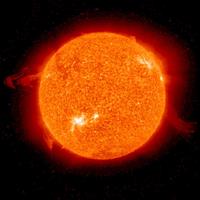
PUMPA - SMART LEARNING
எங்கள் ஆசிரியர்களுடன் 1-ஆன்-1 ஆலோசனை நேரத்தைப் பெறுங்கள். டாப்பர் ஆவதற்கு நாங்கள் பயிற்சி அளிப்போம்
Book Free DemoSun is a fiery spinning ball of hot gases mainly composed of hydrogen and helium with many other gases. It is the main source of energy on Earth.

Sun
Sun is a medium-sized star with three-quarters of hydrogen and one-quarter of helium. Hydrogen atoms combine or fuse together under enormous pressure to form helium in a process called nuclear fusion. A large amount of energy is released as light and heat during the fusion process, making the sunshine.
Sun is the nearest star to Earth, and it is located at the centre of the solar system. The strong gravitational field of the Sun causes other celestial objects such as planets, asteroids, comets, meteoroids, etc, to orbit around it.
Age of Sun:
Our Sun is a million times bigger than Earth, at a distance of approximately \(150,000,000\ km\) from the Earth. The age of our Sun is estimated to be \(4.6\ billion\ years\) old.
Formation of Sun:
After the Big Bang, hydrogen gas condensed to form massive clouds, which eventually consolidated and produced countless galaxies. Some hydrogen gas escaped and began to float around our galaxy. This free-floating hydrogen gas, concentrated over time due to various modifications, paved the way for the birth of the Sun and the planets in the solar system.
The Sun gradually changed into a slowly spinning molecular cloud of hydrogen, helium and dust. As a result of its own gravity, the gas clouds started to compress. Finally, the cloud flattened into a massive giant disc due to its excessive and high-speed spinning.
Important!
The Cosmic year is the time period taken by Sun to complete one revolution around the Milky Way. The Sun takes \(225\ million\ years\) to complete one revolution if it is travelling at a speed of \(9\ lakh\ km/h\) (\(250\ km\ per\ second\)).